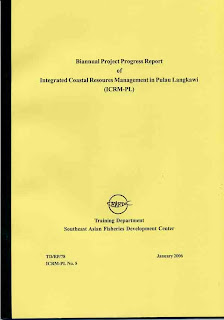 The Consultation with Myanmar Department of Fishery and Site Survey in Duya In Lake, Hinthada, Ayeyarwady, Myanmar on 15-18 December 2008
The Consultation with Myanmar Department of Fishery and Site Survey in Duya In Lake, Hinthada, Ayeyarwady, Myanmar on 15-18 December 2008The objectives were to consult with the government of Myanmar particularly Department of Fisheries on the collaborative program of the Promotion of Inland Small-scale Fisheries Management through Right-based Fisheries Management and Co-management Toward Institution Building and Participatory Approach and also to conduct site survey and data collection of the fishermen livelihood including the status of the aquatic resources in Duya Inn Lake, Hinthada, Ayeyarwady.
 Duya In is in Hinthada, Ayarwaddy Division, adjacent to the Ayarwaddy River and connected with streams and creeks. Ayarwaddy Dam also serves as a pathway for fish to migrate through the fishery site and the river. The water surface area is about 808 acres. At the center of the site, there is an emerging piece of land of about 259 acres which creates a streamline and upwelling, supporting primary production in the fishery.
Duya In is in Hinthada, Ayarwaddy Division, adjacent to the Ayarwaddy River and connected with streams and creeks. Ayarwaddy Dam also serves as a pathway for fish to migrate through the fishery site and the river. The water surface area is about 808 acres. At the center of the site, there is an emerging piece of land of about 259 acres which creates a streamline and upwelling, supporting primary production in the fishery.With regard to the interviewing with some fishers and official in the Duya In leasable Fisheries, the major groups of fisher are including 40 full-time fishers and around 290 local partner fishers. Fishing is conducted with purse seine, drift nets, dredge nets, cast nets and hook and lines. The fishery area is managed with 40 permanent employees. The lessee buys back their catch about 40 Kyats per viss (US$ 0.25 per 10 kilograms).
 Local fisher partners earn 800 to 1,000 Kyats (US$ 0.80-1.00) and even up to 2,500 Kyats (US$ 2.00) per day. In case of the local fisher partner, they usually are fishing around 25 to 30 days a month and operation time mostly from 06.00 pm. until 06.00 am. from August to April. Interviewed fishers, all of them do not have any saving money which only do fishery to earn their life. The township fisheries officer said that before 1991 there were about 23 local species including three major carps, three snakeheads, catfish, carps, and others such as climbing perch, spiny eel, glass fish, feather back, barb, loaches, garfish and eel. However, after 2000, most of the catches are carp species.
Local fisher partners earn 800 to 1,000 Kyats (US$ 0.80-1.00) and even up to 2,500 Kyats (US$ 2.00) per day. In case of the local fisher partner, they usually are fishing around 25 to 30 days a month and operation time mostly from 06.00 pm. until 06.00 am. from August to April. Interviewed fishers, all of them do not have any saving money which only do fishery to earn their life. The township fisheries officer said that before 1991 there were about 23 local species including three major carps, three snakeheads, catfish, carps, and others such as climbing perch, spiny eel, glass fish, feather back, barb, loaches, garfish and eel. However, after 2000, most of the catches are carp species. 
Proposed projects under this consultation, conservation zone and fish processing will be considered and implemented in the future which collaboration among SEAFDEC and Myanmar Department of Fishery.


 The Stakeholder Consultative Workshop on “Revitalization of Protected Area Conservation”
The Stakeholder Consultative Workshop on “Revitalization of Protected Area Conservation”










































